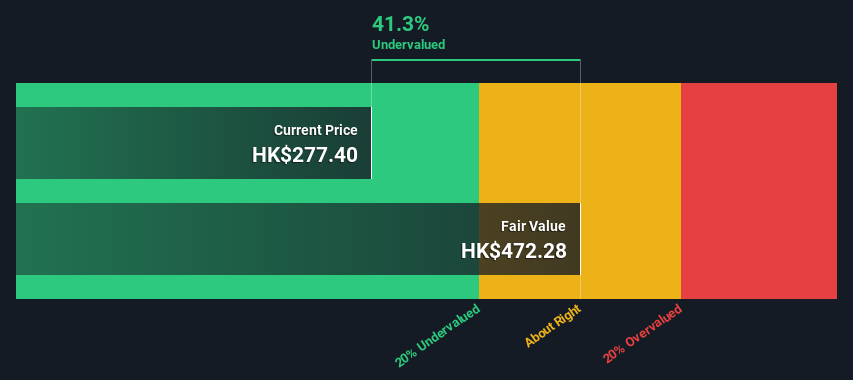- Hong Kong
- /
- Interactive Media and Services
- /
- SEHK:700
Are Investors Undervaluing Tencent Holdings Limited (HKG:700) By 41%?

Key Insights
- The projected fair value for Tencent Holdings is HK$472 based on 2 Stage Free Cash Flow to Equity
- Tencent Holdings' HK$277 share price signals that it might be 41% undervalued
- Analyst price target for 700 is CN¥432 which is 8.5% below our fair value estimate
Does the March share price for Tencent Holdings Limited (HKG:700) reflect what it's really worth? Today, we will estimate the stock's intrinsic value by projecting its future cash flows and then discounting them to today's value. One way to achieve this is by employing the Discounted Cash Flow (DCF) model. There's really not all that much to it, even though it might appear quite complex.
Remember though, that there are many ways to estimate a company's value, and a DCF is just one method. If you still have some burning questions about this type of valuation, take a look at the Simply Wall St analysis model.
View our latest analysis for Tencent Holdings
Step By Step Through The Calculation
We're using the 2-stage growth model, which simply means we take in account two stages of company's growth. In the initial period the company may have a higher growth rate and the second stage is usually assumed to have a stable growth rate. To start off with, we need to estimate the next ten years of cash flows. Where possible we use analyst estimates, but when these aren't available we extrapolate the previous free cash flow (FCF) from the last estimate or reported value. We assume companies with shrinking free cash flow will slow their rate of shrinkage, and that companies with growing free cash flow will see their growth rate slow, over this period. We do this to reflect that growth tends to slow more in the early years than it does in later years.
Generally we assume that a dollar today is more valuable than a dollar in the future, and so the sum of these future cash flows is then discounted to today's value:
10-year free cash flow (FCF) forecast
| 2024 | 2025 | 2026 | 2027 | 2028 | 2029 | 2030 | 2031 | 2032 | 2033 | |
| Levered FCF (CN¥, Millions) | CN¥181.9b | CN¥206.3b | CN¥233.8b | CN¥254.2b | CN¥271.2b | CN¥285.5b | CN¥297.9b | CN¥308.7b | CN¥318.4b | CN¥327.4b |
| Growth Rate Estimate Source | Analyst x12 | Analyst x10 | Analyst x3 | Est @ 8.69% | Est @ 6.69% | Est @ 5.30% | Est @ 4.32% | Est @ 3.64% | Est @ 3.16% | Est @ 2.82% |
| Present Value (CN¥, Millions) Discounted @ 8.4% | CN¥167.8k | CN¥175.5k | CN¥183.5k | CN¥184.0k | CN¥181.1k | CN¥175.9k | CN¥169.3k | CN¥161.8k | CN¥154.0k | CN¥146.0k |
("Est" = FCF growth rate estimated by Simply Wall St)
Present Value of 10-year Cash Flow (PVCF) = CN¥1.7t
The second stage is also known as Terminal Value, this is the business's cash flow after the first stage. For a number of reasons a very conservative growth rate is used that cannot exceed that of a country's GDP growth. In this case we have used the 5-year average of the 10-year government bond yield (2.0%) to estimate future growth. In the same way as with the 10-year 'growth' period, we discount future cash flows to today's value, using a cost of equity of 8.4%.
Terminal Value (TV)= FCF2033 × (1 + g) ÷ (r – g) = CN¥327b× (1 + 2.0%) ÷ (8.4%– 2.0%) = CN¥5.2t
Present Value of Terminal Value (PVTV)= TV / (1 + r)10= CN¥5.2t÷ ( 1 + 8.4%)10= CN¥2.3t
The total value, or equity value, is then the sum of the present value of the future cash flows, which in this case is CN¥4.0t. To get the intrinsic value per share, we divide this by the total number of shares outstanding. Relative to the current share price of HK$277, the company appears quite undervalued at a 41% discount to where the stock price trades currently. The assumptions in any calculation have a big impact on the valuation, so it is better to view this as a rough estimate, not precise down to the last cent.

Important Assumptions
We would point out that the most important inputs to a discounted cash flow are the discount rate and of course the actual cash flows. If you don't agree with these result, have a go at the calculation yourself and play with the assumptions. The DCF also does not consider the possible cyclicality of an industry, or a company's future capital requirements, so it does not give a full picture of a company's potential performance. Given that we are looking at Tencent Holdings as potential shareholders, the cost of equity is used as the discount rate, rather than the cost of capital (or weighted average cost of capital, WACC) which accounts for debt. In this calculation we've used 8.4%, which is based on a levered beta of 1.131. Beta is a measure of a stock's volatility, compared to the market as a whole. We get our beta from the industry average beta of globally comparable companies, with an imposed limit between 0.8 and 2.0, which is a reasonable range for a stable business.
SWOT Analysis for Tencent Holdings
- Debt is not viewed as a risk.
- Earnings growth over the past year underperformed the Interactive Media and Services industry.
- Dividend is low compared to the top 25% of dividend payers in the Interactive Media and Services market.
- Annual revenue is forecast to grow faster than the Hong Kong market.
- Good value based on P/E ratio and estimated fair value.
- Annual earnings are forecast to grow slower than the Hong Kong market.
Looking Ahead:
Whilst important, the DCF calculation shouldn't be the only metric you look at when researching a company. The DCF model is not a perfect stock valuation tool. Rather it should be seen as a guide to "what assumptions need to be true for this stock to be under/overvalued?" For instance, if the terminal value growth rate is adjusted slightly, it can dramatically alter the overall result. What is the reason for the share price sitting below the intrinsic value? For Tencent Holdings, there are three relevant aspects you should look at:
- Risks: For example, we've discovered 1 warning sign for Tencent Holdings that you should be aware of before investing here.
- Future Earnings: How does 700's growth rate compare to its peers and the wider market? Dig deeper into the analyst consensus number for the upcoming years by interacting with our free analyst growth expectation chart.
- Other High Quality Alternatives: Do you like a good all-rounder? Explore our interactive list of high quality stocks to get an idea of what else is out there you may be missing!
PS. Simply Wall St updates its DCF calculation for every Hong Kong stock every day, so if you want to find the intrinsic value of any other stock just search here.
If you're looking to trade Tencent Holdings, open an account with the lowest-cost platform trusted by professionals, Interactive Brokers.
With clients in over 200 countries and territories, and access to 160 markets, IBKR lets you trade stocks, options, futures, forex, bonds and funds from a single integrated account.
Enjoy no hidden fees, no account minimums, and FX conversion rates as low as 0.03%, far better than what most brokers offer.
Sponsored ContentValuation is complex, but we're here to simplify it.
Discover if Tencent Holdings might be undervalued or overvalued with our detailed analysis, featuring fair value estimates, potential risks, dividends, insider trades, and its financial condition.
Access Free AnalysisHave feedback on this article? Concerned about the content? Get in touch with us directly. Alternatively, email editorial-team (at) simplywallst.com.
This article by Simply Wall St is general in nature. We provide commentary based on historical data and analyst forecasts only using an unbiased methodology and our articles are not intended to be financial advice. It does not constitute a recommendation to buy or sell any stock, and does not take account of your objectives, or your financial situation. We aim to bring you long-term focused analysis driven by fundamental data. Note that our analysis may not factor in the latest price-sensitive company announcements or qualitative material. Simply Wall St has no position in any stocks mentioned.
About SEHK:700
Tencent Holdings
An investment holding company, offers value-added services (VAS), online advertising, fintech, and business services in the People’s Republic of China and internationally.
Flawless balance sheet with solid track record.
Similar Companies
Market Insights
Community Narratives



